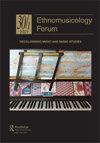谁的jembe?在萨格勒布,作为反文化偶像和非洲真实性象征的鼓
IF 0.5
1区 艺术学
0 MUSIC
引用次数: 0
摘要
摘要jembe在西欧和北欧以及北美的普遍存在,是在20世纪70年代由有影响力的西非jembe演奏者发起的,后来在世界音乐中发展起来,在那里这种鼓代表了“非洲音乐”的精髓。在克罗地亚,jembe直到20世纪90年代末才流行起来,这是受当地克罗地亚音乐家的推动,他们在萨格勒布塑造了非洲音乐的舞台。十多年后,第一批来自西非的表演者——特别是来自塞内加尔的表演者——定居在克罗地亚,并在有限的场景中占据了一个空间,这个场景主要围绕着jembe而具体化。尽管在开放合作的氛围中,这两组jembe表演者之间围绕真实性和劳动问题出现了摩擦。本文重点讨论克罗地亚和塞内加尔jembe从业者之间这场遭遇的最初阶段和利害关系问题。尽管这些紧张关系与世界音乐产业中经常出现的异国情调的话语和挪用概念产生了共鸣,但有人认为,为了理解这种遭遇的复杂性以及萨格勒布非洲音乐场景的形成过程,必须解构笼统的解释和演员的主观解读。本文章由计算机程序翻译,如有差异,请以英文原文为准。
Whose jembe? A drum as a countercultural icon and a symbol of African authenticity in Zagreb
ABSTRACT The ubiquity of the jembe in western and northern Europe, as well as in North America, was instigated during the 1970s by influential West African jembe players, later developing within world music, where this drum came to represent the essence of ‘African music’. In Croatia the popularity of the jembe did not arise until the late 1990s, motivated by local Croatian musicians who shaped an African music scene in Zagreb. More than a decade later, the first performers from West Africa—specifically from Senegal—settled in Croatia and claimed a space in the limited scene that had mainly crystallised around the jembe. Albeit within a climate of open collaboration, frictions emerged between these two groups of jembe performers surrounding issues of authenticity and labour. This article focuses on the initial phases and issues at stake in this encounter between Croatian and Senegalese jembe practitioners. Although these tensions resonate with exoticising discourses and notions of appropriation that have often characterised the world music industry, it is argued that generalising interpretations as well as the actors’ subjective readings must be deconstructed in order to grasp the complexities of this encounter and the processes shaping the African music scene in Zagreb.
求助全文
通过发布文献求助,成功后即可免费获取论文全文。
去求助
来源期刊

Ethnomusicology Forum
MUSIC-
CiteScore
1.10
自引率
25.00%
发文量
29
期刊介绍:
Articles often emphasise first-hand, sustained engagement with people as music makers, taking the form of ethnographic writing following one or more periods of fieldwork. Typically, ethnographies aim for a broad assessment of the processes and contexts through and within which music is imagined, discussed and made. Ethnography may be synthesised with a variety of analytical, historical and other methodologies, often entering into dialogue with other disciplinary areas such as music psychology, music education, historical musicology, performance studies, critical theory, dance, folklore and linguistics. The field is therefore characterised by its breadth in theory and method, its interdisciplinary nature and its global perspective.
 求助内容:
求助内容: 应助结果提醒方式:
应助结果提醒方式:


